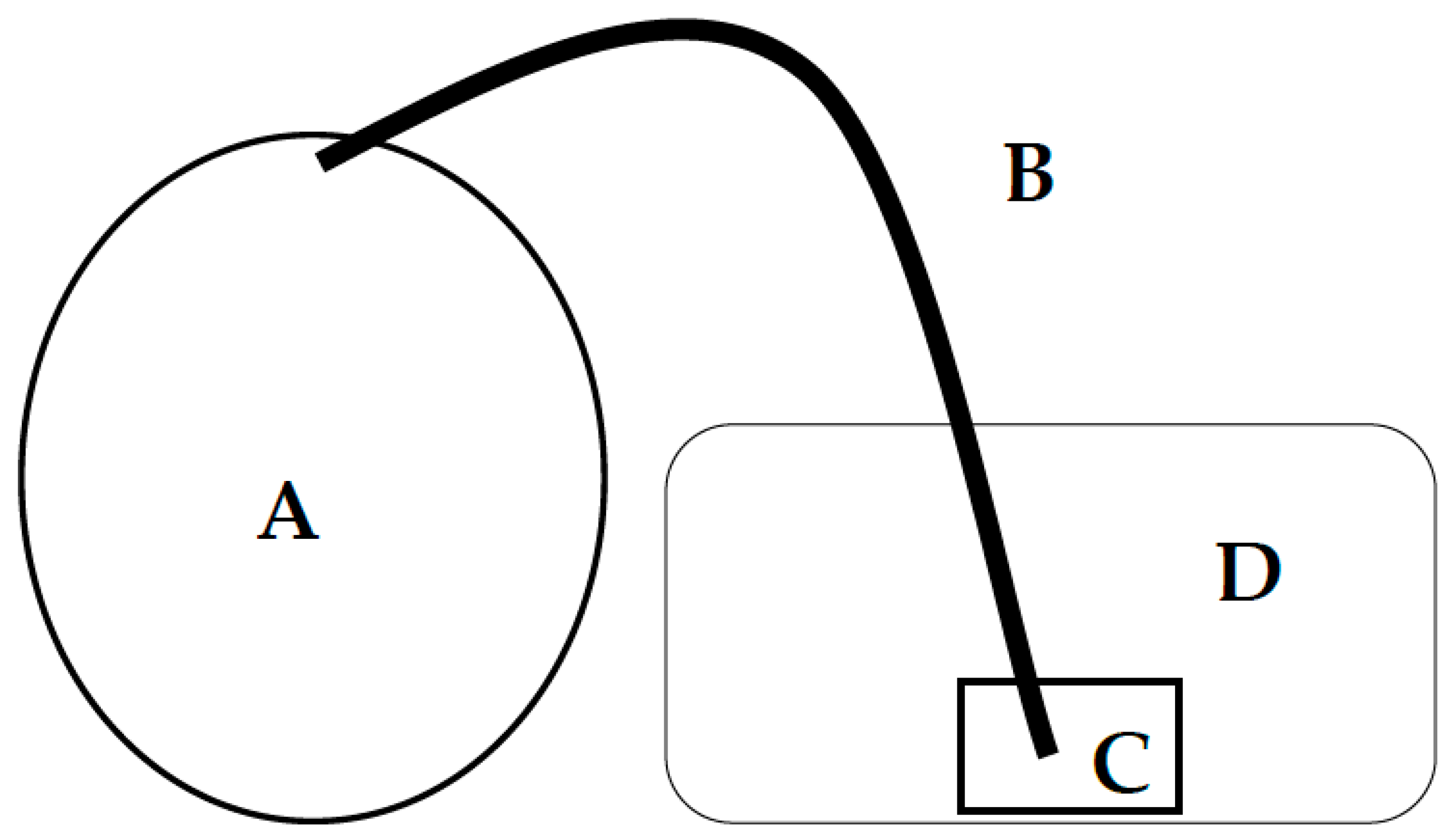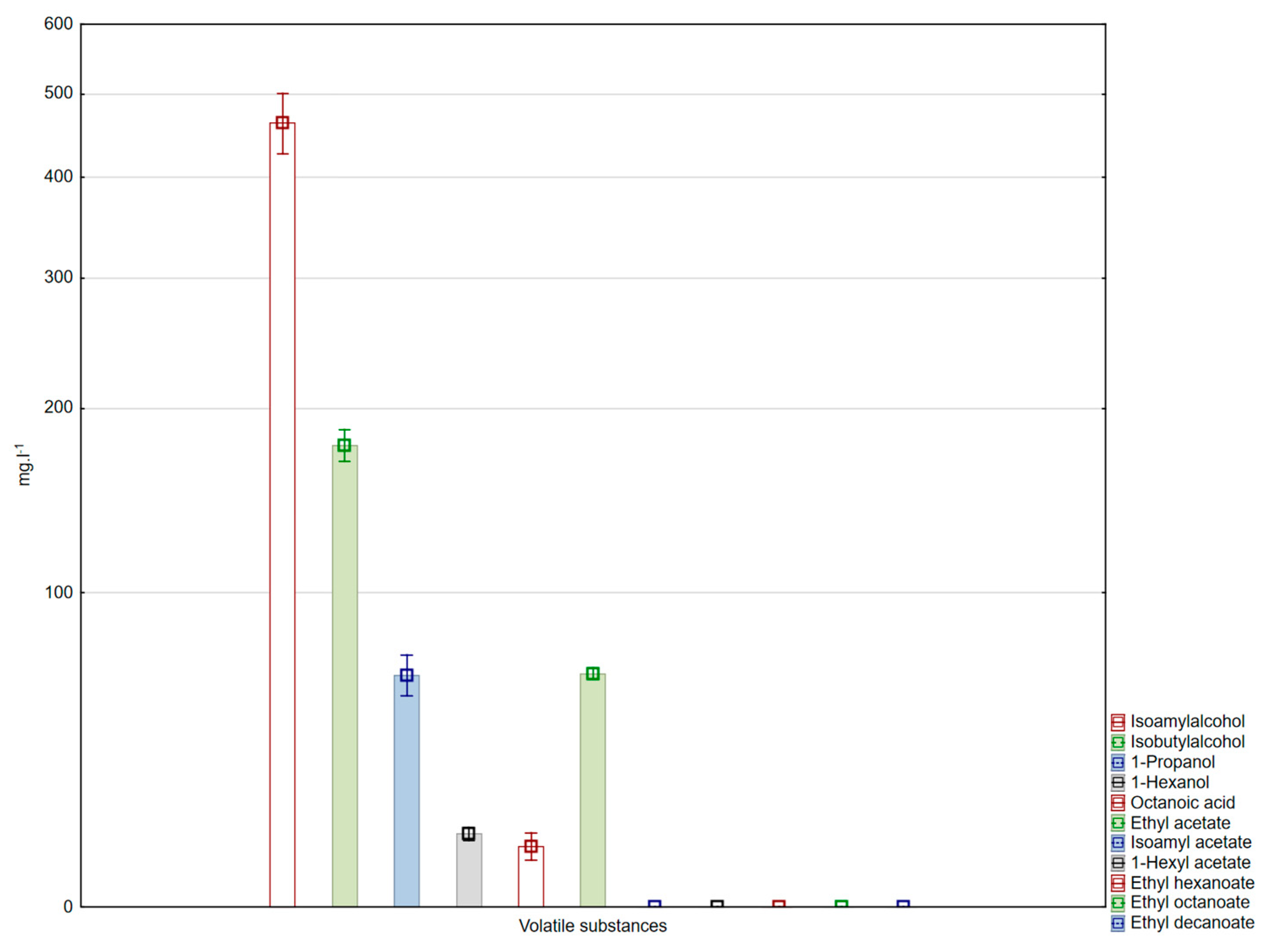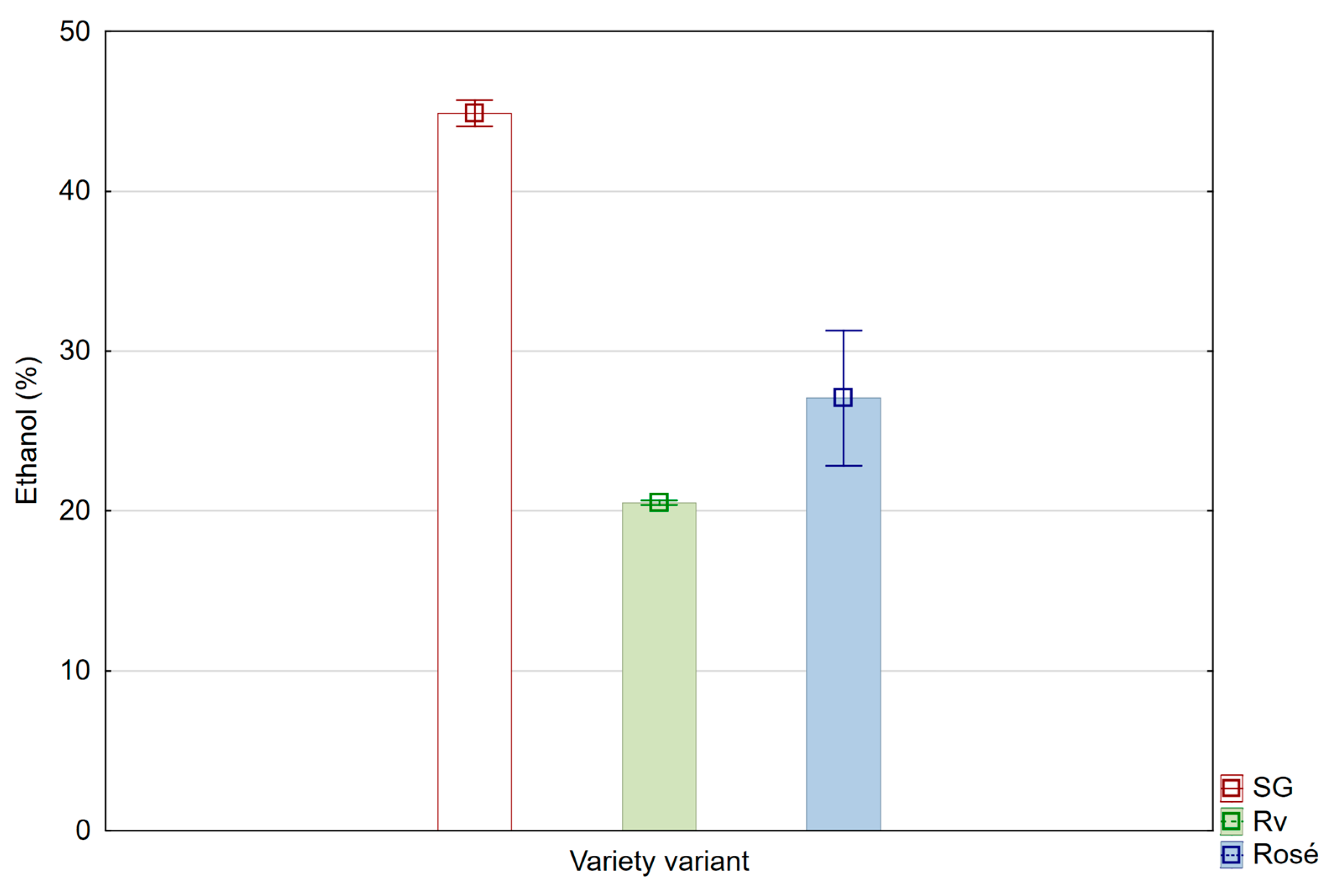A Study of Condensates Collected during the Fermentation of Grape Must
Abstract
:1. Introduction
2. Materials and Methods
2.1. Condensation
2.2. Design of Individual Experiments
2.2.1. Investigation into the Evolution of the Composition of Condensates during Fermentation
2.2.2. An Analysis of the Total Condensate
2.3. Methods Used to Measure the Individual Parameters
2.3.1. Total Titratable Acids
2.3.2. Determination of Sugars (HPLC)
- Column: Watrex Polymer IEX H form 10 μm (Watrex, Praha, Czech Republic); 250 × 8 mm + 10 × 8 mm, separation temperature: 60 °C, sample injection volume: 20 µL.
- Mobile phase flow rate: 0.75 mL/min
- Isocratic elution
- Mobile phase: 1.8 mM H2SO4
- Detection: 190 mn
2.3.3. Determination of Alcohol by Distillation
2.4. Determination of the Quantity of Volatile Compounds in the Condensate
2.5. Statistical Evaluation
3. Results and Discussion
3.1. Evolution of the Condensate Composition during Fermentation
3.1.1. Generation of Undesirable Volatile Components during Fermentation
3.1.2. Evolution of Ethanol Content during Fermentation
3.2. Analysis of the Volatiles in the Condensates of the Different Varieties
4. Conclusions
Author Contributions
Funding
Institutional Review Board Statement
Informed Consent Statement
Data Availability Statement
Conflicts of Interest
References
- Cabrita, M.J.; Freitas, A.M.C.; Laureano, O.; Borsa, D.; Di Stefano, R. Aroma compounds in varietal wines from Alentejo, Portugal. J. Food Compos. Anal. 2007, 20, 375–390. [Google Scholar] [CrossRef]
- Mouret, J.R.; Morakul, S.; Nicolle, P.; Athes, V.; Sablayrolles, J.M. Gas-liquid transfer of aroma compounds during winemaking fermentations. LWT-Food Sci. Technol. 2012, 49, 238–244. [Google Scholar] [CrossRef]
- Morakul, S.; Mouret, J.R.; Nicolle, P.; Trelea, I.C.; Sablayrolles, J.M.; Athes, V. Modelling of the gas-liquid partitioning of aroma compounds during wine alcoholic fermentation and prediction of aroma losses. Process Biochem. 2011, 46, 1125–1131. [Google Scholar] [CrossRef]
- Colibaba, L.C.; Cotea, V.V.; Niculaua, M.; Schmarr, H.G. Volatile compounds captured in exhaust CO2 flow during the fermentation of busuioaca de bohotin wine. Environ. Eng. Manag. J. 2012, 11, 1895–1900. [Google Scholar]
- Francis, I.L.; Newton, J.L. Determining wine aroma from compositional data. Aust. J. Grape Wine Res. 2005, 11, 114–126. [Google Scholar] [CrossRef]
- Sumby, K.M.; Grbin, P.R.; Jiranek, V. Microbial modulation of aromatic esters in wine: Current knowledge and future prospects. Food Chem. 2010, 121, 1–16. [Google Scholar] [CrossRef]
- Neisius, J. Efficient Winemaking with Aroma Recovery through Fermentation Gas Condensation. 2022. Available online: https://www.researchgate.net/publication/364087748_Efficient_winemaking_with_aroma_recovery_through_fermentation_gas_condensation (accessed on 15 January 2024).
- Kukec, A.; Berovic, M.; Celan, S.; Wondra, M. The role of on-line redox potential measurement in Sauvignon blanc fermentation. Food Technol. Biotechnol. 2002, 40, 49–55. [Google Scholar]
- Grossmann, M.; Rapp, A. Enhancement of the variety-typical wine bouquet after enzyme treatment. Deutsch. Lebensm. Rundsch. 1988, 84, 35–37. [Google Scholar]
- Polaskova, P.; Herszage, J.; Ebeler, S.E. Wine flavor: Chemistry in a glass. Chem. Soc. Rev. 2008, 37, 2478–2489. [Google Scholar] [CrossRef]
- Guerrini, L.; Angeloni, G.; Masella, P.; Calamai, L.; Parenti, A. A Technological Solution to Modulate the Aroma Profile during Beer Fermentation. Food Bioprocess Technol. 2018, 11, 1259–1266. [Google Scholar] [CrossRef]
- Norkin, M.; Colome, S.D. Volatile Organic Compound Recovery System and Method. U.S. Patent 8956671B1, 17 February 2015. Available online: https://patents.google.com/patent/US8956671B1/en (accessed on 15 January 2024).
- Muller, C.J.; Wahlstrom, V.L.; Fugelsang, K.C. Capture and use of volatile flavor constituents emitted during wine fermentation. In Beer and Wine Production: Analysis, Characterization, and Technological Advances; Gump, B.H., Ed.; American Chemical Society: San Francisco, CA, USA, 1993; Volume 536, pp. 219–232. [Google Scholar]
- Prusova, B.; Humaj, J.; Kulhankova, M.; Kumsta, M.; Sochor, J.; Baron, M. Capture of Fermentation Gas from Fermentation of Grape Must. Foods 2023, 12, 574. [Google Scholar] [CrossRef] [PubMed]
- Morakul, S.; Mouret, J.R.; Nicolle, P.; Aguera, E.; Sablayrolles, J.M.; Athès, V. A Dynamic Analysis of Higher Alcohol and Ester Release During Winemaking Fermentations. Food Bioprocess Technol. 2013, 6, 818–827. [Google Scholar] [CrossRef]
- Alexandre, H. Contribution à l’étude des bourbes: Influence sur la fermentescibilité des moûts. Rev. Fr. 1994, 146, 11–20. [Google Scholar]
- Vilela-Moura, A.; Schuller, D.; Mendes-Faia, A.; Silva, R.D.; Chaves, S.R.; Sousa, M.J.; Côrte-Real, M. The impact of acetate metabolism on yeast fermentative performance and wine quality: Reduction of volatile acidity of grape musts and wines. Appl. Microbiol. Biotechnol. 2011, 89, 271–280. [Google Scholar] [CrossRef] [PubMed]
- Luong, J.H.T. Kinetics of ethanol inhibition in alcohol fermentation. Biotechnol. Bioeng. 1985, 27, 280–285. [Google Scholar] [CrossRef] [PubMed]
- Tsai, P.C.; Araujo, L.D.; Tian, B. Varietal Aromas of Sauvignon Blanc: Impact of Oxidation and Antioxidants Used in Winemaking. Fermentation 2022, 8, 686. [Google Scholar] [CrossRef]
- Rapp, A.; Versini, G. Influence of nitrogen compounds in grapes on aroma compounds of wines. In Proceedings of the International Symposium on Nitrogen in Grapes and Wine, Seattle, WA, USA, 18–19 June 1995; pp. 156–164. [Google Scholar]
- Swiegers, J.H.; Bartowsky, E.J.; Henschke, P.A.; Pretorius, I.S. Yeast and bacterial modulation of wine aroma and flavour. Aust. J. Grape Wine Res. 2005, 11, 139–173. [Google Scholar] [CrossRef]
- Suklje, K.; Cus, F. Modulation of Welschriesling wine volatiles through the selection of yeast and lactic acid bacteria. OENO One 2021, 55, 245–260. [Google Scholar] [CrossRef]
- Tominaga, T.; Darriet, P.; Dubourdieu, D. Identification of 3-mercaptohexyl acetate in Sauvignon wine, a powerful aromatic compound exhibiting box-tree odor. Vitis 1996, 35, 207–210. [Google Scholar]
- Madzgalj, V.; Petrovic, A.; Cakar, U.; Maras, V.; Sofrenic, I.; Tesevic, V. The influence of different enzymatic preparations and skin contact time on aromatic profile of wines produced from autochthonous grape varieties Krstac and Zizak. J. Serbian Chem. Soc. 2023, 88, 11–23. [Google Scholar] [CrossRef]
- Guerrini, L.; Masella, P.; Spugnoli, P.; Spinelli, S.; Calamai, L.; Parenti, A. A Condenser to Recover Organic Volatile Compounds during Vinification. Am. J. Enol. Vitic. 2016, 67, 163–168. [Google Scholar] [CrossRef]








| Physicochemical Parameters | Sugar | Titrable Acids | pH |
|---|---|---|---|
| Riesling | 22 °BX | 7.7 g·L−1 | 3.1 |
| Physicochemical Parameters | Sugar | Titrable Acids | pH | Village |
|---|---|---|---|---|
| Riesling | 21 °BX | 7.3 g·L−1 | 3.1 | Jasova (Slovakia) |
| Sauvignon blanc | 25.5 °BX | 6.7 g·L−1 | 3.27 | Dubník (Slovakia) |
| Merlot | 21.5 °BX | 7.4 g·L−1 | 3.22 | Jasova (Slovakia) |
Disclaimer/Publisher’s Note: The statements, opinions and data contained in all publications are solely those of the individual author(s) and contributor(s) and not of MDPI and/or the editor(s). MDPI and/or the editor(s) disclaim responsibility for any injury to people or property resulting from any ideas, methods, instructions or products referred to in the content. |
© 2024 by the authors. Licensee MDPI, Basel, Switzerland. This article is an open access article distributed under the terms and conditions of the Creative Commons Attribution (CC BY) license (https://creativecommons.org/licenses/by/4.0/).
Share and Cite
Humaj, J.; Baron, M.; Kumsta, M.; Sochor, J.; Pavlousek, P. A Study of Condensates Collected during the Fermentation of Grape Must. Fermentation 2024, 10, 206. https://doi.org/10.3390/fermentation10040206
Humaj J, Baron M, Kumsta M, Sochor J, Pavlousek P. A Study of Condensates Collected during the Fermentation of Grape Must. Fermentation. 2024; 10(4):206. https://doi.org/10.3390/fermentation10040206
Chicago/Turabian StyleHumaj, Jakub, Mojmir Baron, Michal Kumsta, Jiri Sochor, and Pavel Pavlousek. 2024. "A Study of Condensates Collected during the Fermentation of Grape Must" Fermentation 10, no. 4: 206. https://doi.org/10.3390/fermentation10040206
APA StyleHumaj, J., Baron, M., Kumsta, M., Sochor, J., & Pavlousek, P. (2024). A Study of Condensates Collected during the Fermentation of Grape Must. Fermentation, 10(4), 206. https://doi.org/10.3390/fermentation10040206





